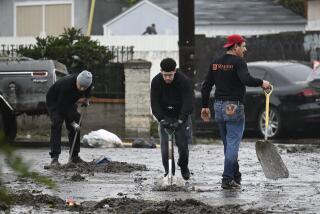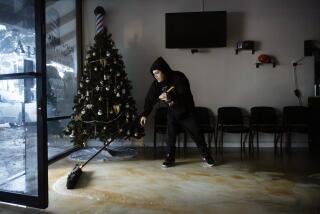Op-Ed: Storms threaten New Camaldoli Hermitage and the monastic way of life
For years now, my neighbors in Santa Barbara have been praying for rain; this season, as we all know, it’s come, with a fearful vengeance. Roads have been closed across the state, and a celebrated 1,000-year-old tree came crashing down, to join the estimated 100 million trees lost to the drought.
Driving toward Palm Springs this January, I was startled to see snowcaps from central Los Angeles. The downpours have offered relief to thousands who have been suffering through an official state of emergency, but, as Teresa of Avila noted long ago, more tears are sometimes shed over answered prayers than unanswered ones.
A few days ago, news came down that the Pfeiffer Canyon Bridge on Highway One, linking San Francisco to Big Sur, had been damaged by the rains and will be shut down for many months, curtailing all access to the promised land of Henry Miller and Aldous Huxley, among many others. (The road to Big Sur also has been blocked by mudslides to the south.) Such world-class resorts as the Post Ranch Inn and the Ventana Inn have had to close their doors for now. At the cathedral of the human-potential movement, the Esalen Institute, 70 people had to prepare to be helicoptered out.
Just south of Esalen, the Benedictine monks of the New Camaldoli Hermitage, and the workers who support them, have been completely cut off from the world — the winding, two-mile road up to their hilltop monastery having been rendered unusable by boulders and rubble. The phones are down, no supplies can be delivered and no one can get in to repair the road.
Monastics are caretakers of humanity, and in an age ever more convulsed by distraction and acceleration, they offer sanctuaries of slowness and reflection.
On assignment in Japan, I have been following from afar the plight of my close friends in the hermitage, where I’ve gone to stay regularly for 26 years. I’m worried about 91-year-old Therese, the wise and elegant French Canadian woman whom the monks have been supporting on their property; about Robert and Gabriel and Emanuel, monks well into their 80s, and not always in the best of health; about everyone, in fact — on the property and off — whose livelihoods will be gone if the heavens aren’t compliant.
In 1996, a brother at the monastery pointed out to me that monks by their nature live on the edge. In trusting to something beyond themselves, they’ve given up most earthly safety nets and protection. Three years after he told me this, residents at the Hermitage had to evacuate as it was encircled by fire. In 2008, two more fires threatened their isolated perch, and in both cases a handful of monks and workers stayed behind to brave the flames and preserve their home.
Living in the margins and at the mercy of the elements is part of what makes a monk a monk. The same year my friends saved the hermitage in Big Sur, the beautiful monastery in the hills above Santa Barbara was reduced to ash by a wildfire. Unable to fund a reconstruction, the monks have had to recreate a place of silence along a busy road close to downtown.
Over the decades, I’ve watched my friends at the hermitage drive visitors in over back roads when rains closed off the highway, wake up before dawn to bake their much-loved fruitcake, try to master computer skills so they can send out those cakes and handle retreatants’ needs with greater efficiency.
Yet the real work monks and nuns do is invisible, and incalculable, as they labor round-the-clock so we occasionally need not. As Thomas Merton pointed out half a century ago, monks are countercultural revolutionaries of a kind who choose to cultivate the inner vineyard so the rest of us can step out of the rush now and then and recollect ourselves and what lies deepest inside of us. Monastics are caretakers of humanity, and in an age ever more convulsed by distraction and acceleration, they offer sanctuaries of slowness and reflection where some of us can return to a more human pace.
Across the globe each day, many find their lives overturned by earthquake or hurricane or wildfire. Monks are better equipped than most to see acts of God as something to live with — bracing reminders of the fact that few things last forever. Yet my friends in white robes are also human enough to know pain, to feel loss and to grow shaky in old age. And as with monastic institutions everywhere, they’re running out of full-time brothers, even as more and more of us long to dip our toes into silence for three or four days. If ill health or storms render the remaining monks unable to serve, a significant part of a 1,000-year-old order may be in peril.
As I follow my friends’ predicament from afar, I’m hoping that acts of providence, or just donations from the many in their debt, may save the lives the monks have been brave enough to fashion. If places of sympathy and inwardness and humility disappear, then all of us are lost.
Pico Iyer is the author, most recently, of “The Art of Stillness” and “The Man Within My Head.”
Follow the Opinion section on Twitter @latimesopinion or Facebook
More to Read
A cure for the common opinion
Get thought-provoking perspectives with our weekly newsletter.
You may occasionally receive promotional content from the Los Angeles Times.






